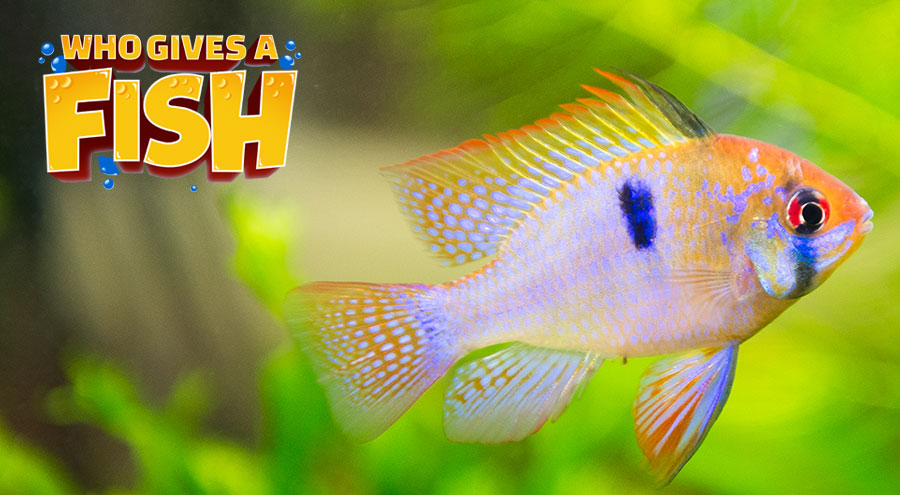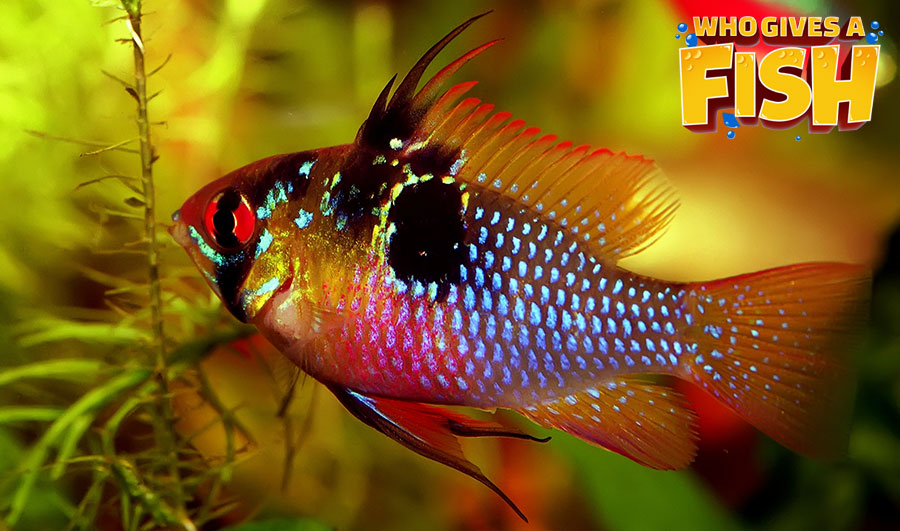Ram Cichlid
The Ram Cichlid, Mikrogeophagus ramirezi, is a popular choice for beginners as it is one of the few Cichlids that are very peaceful. They also stay fairly small and reach a maximum size of approximately 3 inches (7.6 cm). Wild specimens have been found to be twice this size, however, it is unusual in the majority of home aquariums to get this big unless the tank is large.
- Experience Level: Beginner
- Hardiness: Hardy
- Minimum Tank Size: 20 gal (75 L)
- Maximum Size: 3 inches (7.6 cm)
- Temperament: Peaceful
- Temperature: 78 – 85° F (25.6 – 29.4° C)
- pH Range: 6 – 7.5
- Water Hardness: 7 – 14 dGH
- Diet: Omnivore
Table of Contents
Introduction
Aquarium Setup
Difficulty
Feeding
Breeding and Social
There are many different types of Ram Cichlids and various names for them such as the Butterfly Cichlid, Singapore Ram, Blue Ram, and Dwarf Cichlid.
Many breeders have successfully created a variety of different colors and you may also find variations such as the Balloon Ram, German Ram, Electric Blue Ram, Golden Ram, and the Blue German, in your local fish stores.
Many variations of Ram Cichlids are in fact quite small and weak, and will be killed in most community tanks if housed with other aggressive Cichlids.
It is important to clarify with the source you obtain your Ram through, that the parents are strong and healthy fish, as interbreeding with this species can result in low quality fish that may look similar, but have very weak immune systems and produce poor fry.
Aquarium Setup
The Ram Cichlid can be placed in a smaller than usual tank for most Cichlids. A minimum of 20 gallons is recommended, and it is highly recommended that the water flow is weak, while at the same time, is extremely well filtered. High quality water conditions and good oxygenation will assist in overall health and strong coloring.
They will usually leave your plants alone, and are compatible with Java Fern, Wisteria and Amazon Sword varieties.
Diffused lighting is preferred however they will venture into direct light. Floating plants are a great addition for shelter and help in diffusing light in areas of the tank. Java Moss is great option as a floating plant, however, being on the top of the water and in direct light can see this grow rapidly, so prepare to trim the moss out when required. The Java Moss also assists in reducing the pH.
Use a fine sand or gravel substrate and not one that increase your pH levels as the Ram Cichlid is sensitive to high pH.
A weak flow is required as moderate to strong flows are not ideal for this fish. Ensure your water quality is always excellent and tank maintenance schedules are adhered to, as this will ensure a brightly colored and healthy Ram.
Ram Cichlid Aquarium Guide
- Minimum Tank Size: 20 gal (75 L)
- pH Range: 6 – 7.5
- Water Hardness: 7 -14 dGH
- Temperature: 78 – 85° F (25.6 – 29.4° C)
- Lighting: Moderate, diffused lighting
- Substrate: Fine sand/gravel that has no leeching qualities that would increase your pH
- Brackish: No
- Water Flow: Weak/Low
- Tank Region: All areas
Difficulty
The Ram Cichlid is one of the easiest Cichlids to keep and is highly recommended for beginner aquarists. Although they are very hardy, they will still suffer from sudden water parameter changes and do not like high pH levels. As far as difficulty goes, your water parameters more importantly, consistent, optimum levels, are your only main concerns to keeping this fish happy.
Feeding
The Ram is an easy Cichlid to feed and will take just about anything you give it. The best foods to feed are Cichlid specific flake and pellet foods and a good combination of live or frozen foods such as brine shrimp, worms and cyclopeeze. Feeding several smaller amounts per day instead of one or two larger feedings is recommended.
Ram Cichlid Feeding Guide
- Diet: Omnivore
- Frequency: Several small feedings per day
- Pellet Foods: Yes, Cichlid specific pellet food
- Flake Foods: Yes, Cichlid specific pellet food
- Live Foods: Yes
- Meat Foods: Yes, but not from warm blooded animal sources.
- Vegetable Foods: Yes, will often take partly cooked, dark leafy greens
Breeding
It is commonly noted that the males are the larger of the two, and that their dorsal fin can be longer and more pronounced. Darker reds and oranges on the fishes stomach can also signal that it is a female. Older specimens can also be checked by removing them from the tank and observing their vents.
You can breed the Ram Cichlid very easily in a home aquarium. They prefer flat, smooth surfaces such as rocks and big leaves to lay their eggs on, so ensure they have that option, or introduce a broken ceramic/terracotta pot for them to lay eggs on. Keeping the temperature to around 80° F (26.6° C) will also assist in triggering them to breed.
The female lays approximately 200 eggs and the male then fertilizes them. They will remain on the surface on which they were laid and both the male and female will guard them. You will be able to observe them fanning water over the eggs, and they take turns are doing this, without ever really stopping.
Eggs hatch within 3 to 4 days and the parents will usually herd the small fry into a dug out pit in an area of the tank to watch over them. It must be noted, that the parents will eat the fry if they are threatened or hungry and if you want to maximize your yield of survivors, it is best to remove the fry to a separate tank with the same water as the main tank.
Young fry can be fed finely crushed Cichlid specific flake food and foods such as microworm and infusoria. Very small, brine shrimp is also an excellent option, however, depending on the size of the shrimp, it can be 10-14 days before the fry are big enough to eat them.
It is advised to do no more than 10 to 15% water changes during the breeding period and when raising the fry, as sudden changes in overall water parameters can cause stress and/or death of the young fry.
Social
The Ram Cichlid is a very peaceful fish that will do just fine with other peaceful tankmates, although they will become defensive around eggs/fry if they have been breeding in the tank.
Buying 5 to 6 of these will almost always guarantee you end up with a breeding pair, and provided your water filtration is good enough, you can add even more. A big display tank with a dozen or more Ram Cichlids is certainly a spectacular aspect to any freshwater aquarium and they bring a breath of fresh air with their peaceful nature, compared to other Cichlids.



